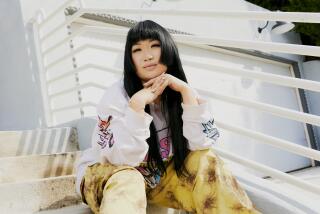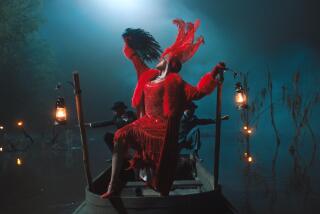Discovering the Perfect Season--and the Colors--of Your Life
- Share via
Once color analyst Pat Jensen drapes you in a rainbow of colors, dusts pastel hues on your eyelids and pairs you with a season, you may never see yourself the same way again.
Jensen is one of a number of Orange County color analysts who provide one-on-one consultations with men and women to determine their most flattering colors. The sessions--based on the much-publicized four-seasons color theory pioneered by Gerrie Pinckney, owner of the Fashion Academy in Costa Mesa--are held in Jensen’s Huntington Beach home.
Intended as a guide to choosing attractive clothing and makeup, the analysis first determines a client’s season of color based on skin tone. Once the season is determined, the client gets a color palette that shows a range of flattering shades for clothes and accessories. The analysis lasts 2 hours and costs $45.
Jensen, a tall “winter” brunette with a perky personality, has been a color analyst since 1975. She points out that colors can help or hurt. For example, if you are a “winter” and wear brown, you get a Halloween effect. If you are a “spring with peachy keen skin” and wear rose blush, you get a clown effect.
If you are a “spring,” Jensen will drape aqua and royal-blue chiffon scarfs around your neck to illustrate how these colors enhance your skin tones. If you are a “winter,” she will layer you with reds, deep greens and black. “Autumns” glow in oranges and brown, and “summers” shine in blues and pinks.
“Some universal colors--periwinkle and turquoise blue--can be worn by anybody,” Jensen said.
Choosing the right colors is also a matter of psychology, she said, explaining: “Blondes and strawberry blondes are more approachable and friendly looking. People perceive them as less intimidating, but sometimes they don’t get the respect they deserve. Colors can help with this. What we have to do is tailor their wardrobes to the individual’s color, stature and personality.”
Once the colors are determined, it’s time to go shopping.
Jensen said wardrobes should consist of seasonal neutrals (camel for “springs,” black for “winters”) and several seasonal accent colors, such as pale blue for “summers” and orange for “autumns.” The colors identified with each season not only harmonize with the individual’s skin and eyes, they blend with each other.
“You have to remember that the seasons don’t mix. Black (a winter color) and tan (a spring color) together is a schizophrenic look. It’s Halloween, like orange and black. You don’t work a wardrobe around Halloween colors. It’s unworkable and you’re spending too much money when you have a schizophrenic closet.”
Pinckney said she developed the four-seasons theory in the 1960s when she began studying how color affects a person’s appearance and wardrobe planning.
Shortly after she devised the seasonal concept, Pinckney began offering classes in wardrobe planning, color theory and makeup. The Fashion Academy, which Pinckney opened in 1972, offers private consultations (at $45 for a 2-hour color analysis) as well as a 9-week, $2,300 training course and exam through which color consultants can obtain a post-secondary certificate from the state Department of Education.
Pinckney trained Carole Jackson, who in 1981 wrote the book “Color Me Beautiful.” Now accredited by the state, the academy has certified more than 40 color analysts in the county and more than 1,000 worldwide, Pinckney said.
Jensen, who has her certificate, said her typical customers are women who want to know what colors they should use in their wardrobes. But she has also had “lawyers bring in scruffy clients who need to look like they didn’t do it and lobbyists from Sacramento who have to look honest.”
The seasonal approach has some detractors. Carlton Wagner, director of the Wagner Institute for Color Research in Santa Barbara, said that the color theories promoted by analysts are “useful things to know, but they don’t go far enough.”
“Most of them are talking about what they find aesthetically pleasing to them, not how others will respond to the colors,” said Wagner, who forecasts the hottest product colors for major corporations. “Analysts might suggest wearing blue-based colors, which appeal more to women than men, who prefer yellow-based colors. You should wear the colors that will please who you’re trying to please.”
Wagner said he used to go to color analysts.
“They kept telling me to wear forest green. I said, ‘I will, as soon as I change my name to Robin Hood.’ You see, you have to take into account where you are wearing these colors. In theory it works, but for practical matters it doesn’t always make sense.”
Some people do take the color theory too far, said Jensen, who was wearing a navy-blue suit with a ruffled powder-blue blouse. Some “summers” won’t be caught dead in anything yellow; some “winters” won’t wear brown even in a pair of shoes.
“This is not a bible--they are just guidelines,” she said. “Don’t try to match colors perfectly with your color palette--just learn the basics of color theory. Usually if (a client) knows how to work her colors, she looks younger and doesn’t spend as much money on unworkable clothes.”






